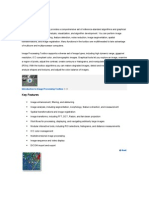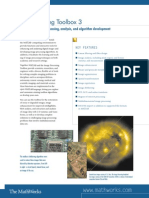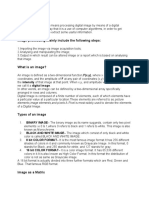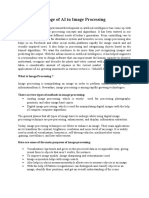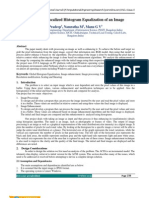Image Processing Toolbox
Image Processing Toolbox
Uploaded by
Hiếu NguyễnCopyright:
Available Formats
Image Processing Toolbox
Image Processing Toolbox
Uploaded by
Hiếu NguyễnCopyright
Available Formats
Share this document
Did you find this document useful?
Is this content inappropriate?
Copyright:
Available Formats
Image Processing Toolbox
Image Processing Toolbox
Uploaded by
Hiếu NguyễnCopyright:
Available Formats
Getting Started with Image Processing Toolbox 4:44
Explore Image Processing Toolbox capabilities for segmentation, morphology, image
statistics, and Hough transform.
Image Processing Toolbox
Perform image processing, analysis, and algorithm development
Image Processing Toolboxprovides a comprehensive set of reference-standard algorithms and graphical tools
for image processing, analysis, visualization, and algorithm development. You can perform image enhancement,
image deblurring, feature detection, noise reduction, image segmentation, geometric transformations, and image
registration. Many toolbox functions are multithreaded to take advantage of multicore and multiprocessor
computers.
Image Processing Toolbox supports a diverse set of image types, including high dynamic range, gigapixel
resolution, embedded ICC profile, and tomographic. Graphical tools let you explore an image, examine a region
of pixels, adjust the contrast, create contours or histograms, and manipulate regions of interest (ROIs). With
toolbox algorithms you can restore degraded images, detect and measure features, analyze shapes and textures,
and adjust color balance.
Key Features
Image enhancement, filtering, and deblurring
Image analysis, including segmentation, morphology, feature extraction, and measurement
Spatial transformations and image registration
Image transforms, including FFT, DCT, Radon, and fan-beam projection
Workflows for processing, displaying, and navigating arbitrarily large images
Modular interactive tools, including ROI selections, histograms, and distance measurements
ICC color management
Multidimensional image processing
Image-sequence and video display
DICOM import and export
Importing and Exporting Images
Image Processing Toolbox supports images generated by a wide range of devices, including digital cameras,
satellite and airborne sensors, medical imaging devices, microscopes, telescopes, and other scientific instruments.
You can visualize, analyze, and process these images in many data types, including single-precision and
double-precision floating-point and signed and unsigned 8-bit, 16-bit, and 32-bit integers.
There are several ways to import and export images into and out of the MATLAB
environment for processing.
You can use Image Acquisition Toolboxto acquire live images from Web cameras, frame grabbers, DCAM
cameras, GigE Vision cameras, and other devices. Using Database Toolbox, you can access images stored in
ODBC-compliant or JDBC-compliant databases.
1
Standard and Specialized Formats Supported
MATLAB supports standard data and image formats, including JPEG, JPEG-2000, TIFF, PNG, HDF, HDF-EOS,
FITS, Microsoft
Excel
, ASCII, and binary files. It also supports the multiband image formats BIP and BIL, as
used by LANDSAT. Low-level I/O and memory mapping functions enable you to develop custom routines for
working with any data format.
Image Processing Toolbox supports a number of specialized image file formats. For medical images, it supports
DICOM files, including associated metadata, as well as the Analyze 7.5 and Interfile formats. The toolbox can
also read geospatial images in NITF files and high dynamic range images in HDR files.
Exploring Slices from a 3-Dimensional MRI Data Set
Interpolating and reslicing a 3D MRI data set.
Displaying and Exploring Images
Displaying Images
Image Processing Toolbox provides image display capabilities that are highly customizable. You can create
displays with multiple images in a single window, annotate displays with text and graphics, and create specialized
displays such as histograms, profiles, and contour plots.
The toolbox includes tools for displaying video and sequences in either a time-lapsed video viewer or an image
montage. Volume visualization tools in MATLAB let you create isosurface displays of multidimensional image
data sets.
Video viewer paused on an individual frame of a video sequence.
Video viewer paused on an individual frame of a video sequence.
Exploring Images
In addition to display functions, the toolbox provides a suite of interactive tools for exploring images. You can
view image information, zoom and pan around the image, and closely examine a region of pixels. You can
interactively place and manipulate ROIs, including points, lines, rectangles, polygons, ellipses, and freehand
2
shapes. You can also interactively crop, adjust the contrast, and measure distances. The suite of tools is available
within Image Tool or from individual functions that you can use to create custom interfaces.
Enhancing Multispectral Color Composite Images
Constructing color composites to highlight and segment vegetation in satellite imagery.
Detecting Cars in a Video of Traffic
Visualizing and analyzing videos and image sequences.
Preprocessing and Postprocessing Images
Image Processing Toolbox provides reference-standard algorithms for preprocessing and postprocessing tasks that
solve frequent system problems, such as interfering noise, low dynamic range, out-of-focus optics, and the
difference in color representation between input and output devices.
Image Enhancement
Image enhancement techniques in Image Processing Toolbox enable you to increase the signal-to-noise ratio and
accentuate image features by modifying the colors or intensities of an image. You can:
Perform histogram equalization
Perform decorrelation stretching
Remap the dynamic range
Adjust the gamma value
Perform linear, median, or adaptive filtering
The toolbox includes specialized filtering routines and a generalized multidimensional filtering function that
handles integer image types, offers multiple boundary-padding options, and performs convolution and correlation.
Predefined filters and functions for designing and implementing your own linear filters are also provided.
Contrast Enhancement Techniques
Enhancing grayscale and truecolor images with adaptive histogram equalization.
Image Deblurring
Image deblurring algorithms in Image Processing Toolbox include blind, Lucy-Richardson, Wiener, and
regularized filter deconvolution, as well as conversions between point spread and optical transfer functions. These
functions help correct blurring caused by out-of-focus optics, movement by the camera or the subject during
image capture, atmospheric conditions, short exposure time, and other factors. All deblurring functions work with
multidimensional images.
Deblurring Images Using a Regularized Filter
Restoring a blurred and noisy image using a constrained least square restoration algorithm.
3
Deblurring Images Using the Blind Deconvolution Algorithm
Restoring an image when no information about the distortion is available.
Device-Independent Color Management
Device-independent color management in Image Processing Toolbox enables you to accurately represent color
independently from input and output devices. This is useful when analyzing the characteristics of a device,
quantitatively measuring color accuracy, or developing algorithms for several different devices. With specialized
functions in the toolbox, you can convert images between device-independent color spaces, such as sRGB, XYZ,
xyY, L*a*b*, uvL, and L*ch.
Color-Based Segmentation Using the L*a*b* Color Space
Identifying different colors by analyzing an image in an alternative color space.
For more flexibility and control, the toolbox supports profile-based color space conversions using a color
management system based on ICC version 4. For example, you can import n-dimensional ICC color profiles,
create new or modify existing ICC color profiles for specific input and output devices, specify the rendering
intent, and find all compliant profiles on your machine.
Image Transform
Image transforms such as FFT and DCT play a critical role in many image processing tasks, including image
enhancement, analysis, restoration, and compression. Image Processing Toolbox provides several image
transforms, including Radon and fan-beam projections. You can reconstruct images from parallel-beam and
fan-beam projection data (common in tomography applications). Image transforms are also available in MATLAB
and Wavelet Toolbox.
Reconstructing an Image from Projection Data
Comparing the reconstruction of an image using parallel (Radon) and fan-beam geometries.
Image Conversion
Image conversions between data classes and image types are a common requirement for imaging applications.
Image Processing Toolbox provides a variety of utilities for conversion between data classes, including single-
and double-precision floating-point and signed or unsigned 8-, 16-, and 32-bit integers. The toolbox includes
algorithms for conversion between image types, including binary, grayscale, indexed color, and truecolor.
Specifically for color images, the toolbox supports a variety of color spaces (such as YIQ, HSV, and YCrCb) as
well as Bayer pattern encoded and high dynamic range images.
Analyzing Images
Image Processing Toolbox provides a comprehensive suite of reference-standard algorithms and graphical tools
for image analysis tasks such as statistical analysis, feature extraction, and property measurement.
Statistical Functions
Statistical functions let you analyze the general characteristics of an image by:
4
Color-Based Segmentation with Live Image Acquisition 5:11
Acquire an image and perform image analysis to find small objects, count them, and
differentiate them by color.
Computing the mean or standard deviation
Determining the intensity values along a line segment
Displaying an image histogram
Plotting a profile of intensity values
Correcting Nonuniform Illumination
Enhancing an image and computing statistics of segmented objects using REGIONPROPS.
Identifying Round Objects
Thresholding an image and calculating measurements of objects.
Edge-Detection Algorithms
Edge-detection algorithms let you identify object boundaries in an image. These algorithms include the Sobel,
Prewitt, Roberts, Canny, and Laplacian of Gaussian methods. The powerful Canny method can detect true weak
edges without being fooled by noise.
Image Segmentation Algorithms
Image segmentation algorithms determine region boundaries in an image. You can explore many different
approaches to image segmentation, including automatic thresholding, edge-based methods, and
morphology-based methods such as the watershed transform, often used to segment connected objects.
Marker-Controlled Watershed Segmentation
Separating overlapping objects into catchment basins and watershed ridge lines.
Detecting a Cell Using Image Segmentation
Segmenting a cell using edge detection and morphology.
Morphological Operators
Morphological operators enable you to detect edges, enhance contrast, remove noise, segment an image into
regions, thin regions, or perform skeletonization on regions. Morphological functions in Image Processing
Toolbox include:
Erosion and dilation
5
Opening and closing
Labeling of connected components
Watershed segmentation
Reconstruction
Distance transform
Texture Segmentation Using Texture Filters
Identifying regions of different textures using entropy measurements and morphological operations.
Advanced Image Analysis
Image Processing Toolbox also contains advanced image analysis functions that let you:
Measure the properties of a specified image region, such as the area, center of mass, or bounding box
Detect lines and extract line segments from an image using the Hough transform
Measure properties, such as surface roughness or color variation, using texture analysis functions
Geometric Transformations and Image Registration
Geometric transformations are useful for tasks such as rotating an image, reducing its resolution, correcting
geometric distortions, and performing image registration. Image Processing Toolbox supports simple operations,
such as resizing, rotating, and cropping, as well as more complex 2D geometric transformations, such as affine
and projective. The toolbox also provides a flexible and comprehensive framework for creating and applying
customized geometric transformations and interpolation methods for N-dimensional arrays.
Image registration is important in remote sensing, medical imaging, and other applications where images must be
aligned to enable quantitative analysis or qualitative comparison. Image Processing Toolbox supports
intensity-based image registration, which automatically aligns images using relative intensity patterns. The
toolbox also supports control-point image registration, which requires the manual selection of control points in
each image to align two images. Additionally, Computer Vision System Toolboxsupports feature-based image
registration, which automatically aligns images using feature detection, extraction, and matching followed by
geometric transformation estimation.
Registering an Aerial Photo to an Orthophoto
Aligning two images using control-point selection.
Registering Multimodal MRI Images
Aligning two MRI images using intensity-based image registration.
Some images are so large that they are difficult to process and display with standard methods. Image Processing
Toolbox provides workflows specifically for working with larger images. Without loading a large image entirely
into memory, you can create a reduced-resolution data set (R-Set) that divides an image into spatial tiles and
6
Product Details, Examples, and System Requirements
www.mathworks.com/products/image
Trial Software
www.mathworks.com/trialrequest
Sales
www.mathworks.com/contactsales
Technical Support
www.mathworks.com/support
resamples the image at different resolution levels. Using this workflow improves image display and navigation
performance. You can use a block processing workflow to apply a function to each distinct block of a large image,
significantly reducing memory use. In this workflow, you can use Parallel Computing Toolboxto further
improve performance.
Block Processing Large Images
Reducing memory use for processing large images by incrementally reading, processing, and
writing results back to disk.
Computing Statistics for Large Images
Calculating and applying global statistics when processing large images with BLOCKPROC.
Resources
Online User Community
www.mathworks.com/matlabcentral
Training Services
www.mathworks.com/training
Third-Party Products and Services
www.mathworks.com/connections
Worldwide Contacts
www.mathworks.com/contact
2012 The MathWorks, Inc. MATLAB and Simulink are registered trademarks of The MathWorks, Inc. See www.mathworks.com/trademarks for a list of
additional trademarks. Other product or brand names may be trademarks or registered trademarks of their respective holders.
7
You might also like
- MATLAB Image Processing ToolboxDocument7 pagesMATLAB Image Processing ToolboxJohn Bofarull GuixNo ratings yet
- Introduction To Image Processing ToolboxDocument7 pagesIntroduction To Image Processing ToolboxGeetha ShreeNo ratings yet
- Matlab Image ProcessingDocument6 pagesMatlab Image ProcessingAfrasinei Sergiu VladNo ratings yet
- Image Processing Mainly Include The Following Steps:: IPPR Unit-1Document8 pagesImage Processing Mainly Include The Following Steps:: IPPR Unit-1Tanmay SharmaNo ratings yet
- CV 2Document14 pagesCV 2Bilal KhanNo ratings yet
- Chapter 4Document8 pagesChapter 4SAsuke UchihANo ratings yet
- 1.a Still ImagesDocument12 pages1.a Still ImagesMahak SatijaNo ratings yet
- Seminar On "Image Processing"Document20 pagesSeminar On "Image Processing"Sudhir Phophaliya100% (1)
- Conceptos de VisiónDocument56 pagesConceptos de VisiónKeromy LeeNo ratings yet
- Introduction To Digital Image Processing: OutlineDocument24 pagesIntroduction To Digital Image Processing: OutlineMalwatteNo ratings yet
- Bio-Medical Image ProcessingDocument82 pagesBio-Medical Image ProcessingPRASANTH KUMAR JNo ratings yet
- Basic Image OpeartionDocument13 pagesBasic Image Opeartionarbaazkhan5735No ratings yet
- Intro Adobe Photoshop HandoutDocument18 pagesIntro Adobe Photoshop HandoutEKNo ratings yet
- Unit 4 - NotesDocument16 pagesUnit 4 - Notesayanj9990No ratings yet
- IntroductionDocument32 pagesIntroductionRitika GhoshNo ratings yet
- 12.6 Advanced Analysis and ClassificationDocument21 pages12.6 Advanced Analysis and ClassificationJose Luis FloresNo ratings yet
- Computer Vision Toolbox (Matlab)Document10 pagesComputer Vision Toolbox (Matlab)Hotland SitorusNo ratings yet
- Paper Presentation "Image Processing"Document20 pagesPaper Presentation "Image Processing"rajkutitNo ratings yet
- Intro Adobe Photoshop HandoutDocument13 pagesIntro Adobe Photoshop Handoutoyindamola ayobamiNo ratings yet
- Biomedical Image ProcessingDocument24 pagesBiomedical Image ProcessingDamien LeongNo ratings yet
- AutoCAD Raster Design 2008Document8 pagesAutoCAD Raster Design 2008Greta CimpanezaNo ratings yet
- Unit-4 Digital Imaging-Norepages30Document31 pagesUnit-4 Digital Imaging-Norepages30aSQUARE test seriesNo ratings yet
- ANLPDocument25 pagesANLPVamsi ReddyNo ratings yet
- A Review On Image ProcessingDocument10 pagesA Review On Image ProcessingAlexander DeckerNo ratings yet
- Digital Image ProcessingDocument46 pagesDigital Image Processingshakti139100% (1)
- 3D DoctorDocument34 pages3D DoctorSangeetha Anisha PintoNo ratings yet
- Dip Module 1 NotesDocument33 pagesDip Module 1 Notesvijaylaxmi-cseNo ratings yet
- CH - 3 Images and GraphicsDocument29 pagesCH - 3 Images and GraphicsAmrit SapkotaNo ratings yet
- Prepared By:-: Parvshree Roll No. 37Document34 pagesPrepared By:-: Parvshree Roll No. 37Sangeeta BansalNo ratings yet
- NotesDocument34 pagesNotesSuhaana KhanNo ratings yet
- DIP Reference NotesDocument54 pagesDIP Reference NotesAravindNo ratings yet
- Digital Image ProcessingDocument26 pagesDigital Image Processingashishk1616No ratings yet
- Image WordDocument5 pagesImage WordSai RoyalsNo ratings yet
- B01MFDS5W7Document199 pagesB01MFDS5W7GifronNo ratings yet
- Computer Vision System ToolboxDocument10 pagesComputer Vision System ToolboxClaudia Angélica Rivera RomeroNo ratings yet
- IpDocument7 pagesIpVinit WadgaonkarNo ratings yet
- An Implementation and Design A Customized Advanced Image Editor Using Image Processing in MatlabDocument5 pagesAn Implementation and Design A Customized Advanced Image Editor Using Image Processing in MatlabIJSTENo ratings yet
- Module 1 DipDocument4 pagesModule 1 DipUMANG PEDNEKARNo ratings yet
- MTG Objective NCERT ChemistryDocument7 pagesMTG Objective NCERT Chemistryr3224505No ratings yet
- IMAGING-INFORMATICS (Radiologic Technologist)Document4 pagesIMAGING-INFORMATICS (Radiologic Technologist)24crtwhd2gNo ratings yet
- Usage of AI in Image ProcessingDocument3 pagesUsage of AI in Image ProcessingVrushali patilNo ratings yet
- LM of DataDocument5 pagesLM of Datatn20jashytNo ratings yet
- CE 701: Remote Sensing Technology Lab Exercise 1: Introduction To ERDAS ImagineDocument10 pagesCE 701: Remote Sensing Technology Lab Exercise 1: Introduction To ERDAS ImagineraaaaajjjjjNo ratings yet
- Ankit &pawan (DIP-Soln)Document26 pagesAnkit &pawan (DIP-Soln)mkumari96166No ratings yet
- Computer Vision: Dr. Sukhendu Das Deptt. of Computer Science and Engg., IIT Madras, Chennai - 600036Document21 pagesComputer Vision: Dr. Sukhendu Das Deptt. of Computer Science and Engg., IIT Madras, Chennai - 600036Sunil NaikNo ratings yet
- Digital Image Fundamentals1Document28 pagesDigital Image Fundamentals1Chandan KumarNo ratings yet
- Currency Recognition System Using Image ProcessingDocument3 pagesCurrency Recognition System Using Image ProcessingkashmiraNo ratings yet
- Image ProcessingDocument9 pagesImage Processingnishu chaudharyNo ratings yet
- Image Processing Unit 1Document22 pagesImage Processing Unit 1malleswarimalleswari584No ratings yet
- International Journal of Computational Engineering Research (IJCER)Document15 pagesInternational Journal of Computational Engineering Research (IJCER)International Journal of computational Engineering research (IJCER)No ratings yet
- UNIT1Document4 pagesUNIT1Tajammul Hussain MistryNo ratings yet
- Chapter 3Document15 pagesChapter 3Rishi MishraNo ratings yet
- A Brief Study of Various Noise Model and Filtering TechniquesDocument6 pagesA Brief Study of Various Noise Model and Filtering TechniquesVyasDjvNo ratings yet
- Husseina Ozigi Otaru Final ReportDocument27 pagesHusseina Ozigi Otaru Final ReportRohit GuptaNo ratings yet
- 6.digital Image ProcessingDocument50 pages6.digital Image Processingvidit112001No ratings yet
- Color Management System: Optimizing Visual Perception in Digital EnvironmentsFrom EverandColor Management System: Optimizing Visual Perception in Digital EnvironmentsNo ratings yet
- AN IMPROVED TECHNIQUE FOR MIX NOISE AND BLURRING REMOVAL IN DIGITAL IMAGESFrom EverandAN IMPROVED TECHNIQUE FOR MIX NOISE AND BLURRING REMOVAL IN DIGITAL IMAGESNo ratings yet
- Aphelion Software: Unlocking Vision: Exploring the Depths of Aphelion SoftwareFrom EverandAphelion Software: Unlocking Vision: Exploring the Depths of Aphelion SoftwareNo ratings yet
- Pyramid Image Processing: Exploring the Depths of Visual AnalysisFrom EverandPyramid Image Processing: Exploring the Depths of Visual AnalysisNo ratings yet
- Global Light Vehicle Engine Cooling Market - Forecasts To 2030 - 2016 Q1 Edition - Technologies - Car Care BookDocument11 pagesGlobal Light Vehicle Engine Cooling Market - Forecasts To 2030 - 2016 Q1 Edition - Technologies - Car Care BookHiếu NguyễnNo ratings yet
- Ai InstlDocument278 pagesAi InstlHiếu NguyễnNo ratings yet
- ANSYS, Inc. Documentation ErrataDocument14 pagesANSYS, Inc. Documentation ErrataHiếu NguyễnNo ratings yet
- Ansoft Motor ManualDocument76 pagesAnsoft Motor ManualMing-tsan Peng100% (1)
- Design Report Cyclotron 33Document12 pagesDesign Report Cyclotron 33Hiếu NguyễnNo ratings yet

